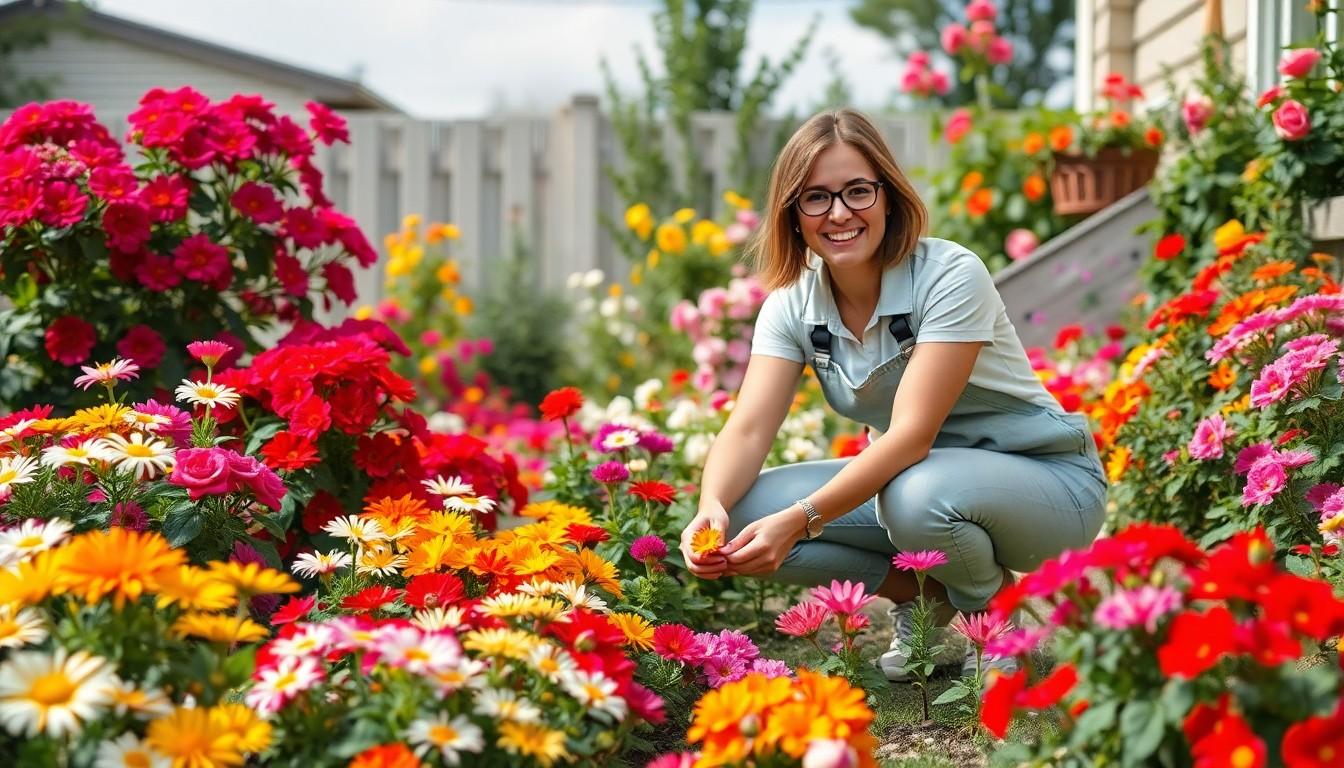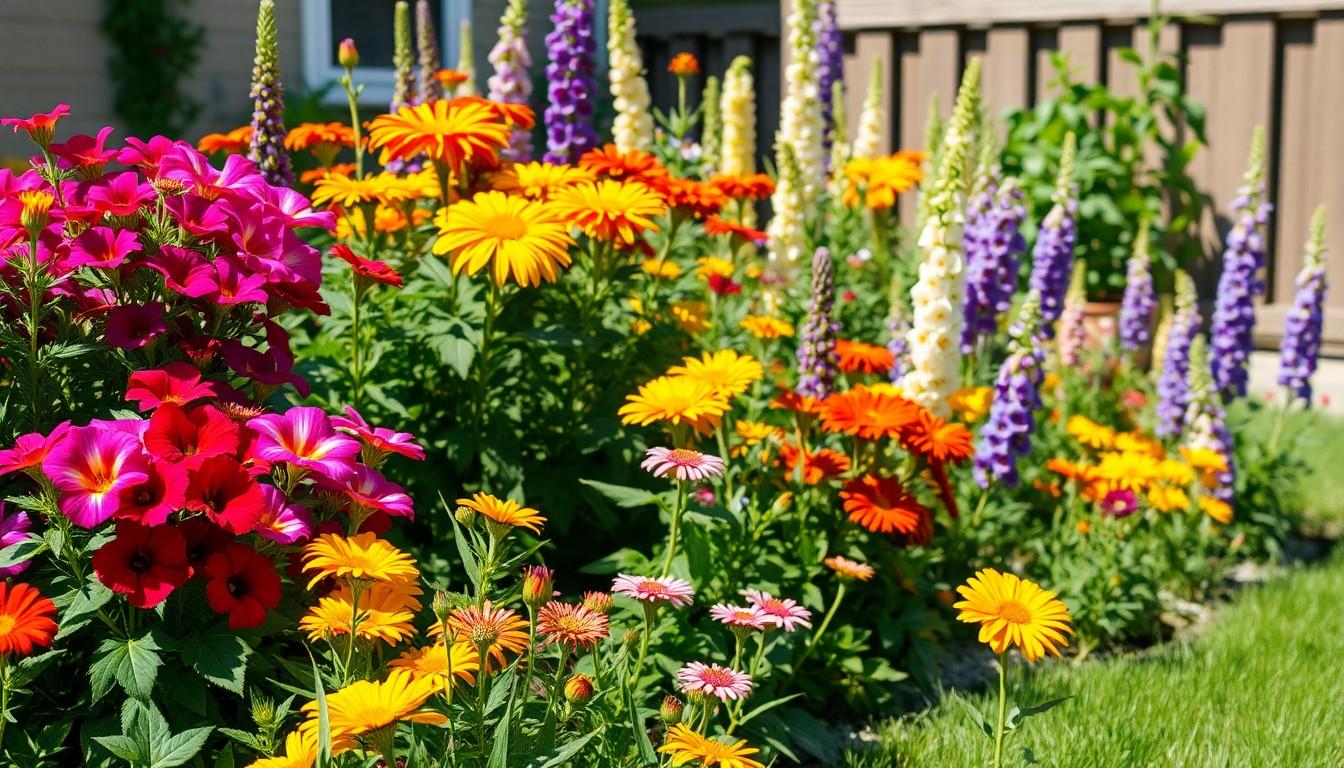The Best Fluffy Pancakes recipe you will fall in love with. Full of tips and tricks to help you make the best pancakes.

Outdoor Flower Plants: Transform Your Backyard into a Vibrant Oasis Today
Imagine stepping into your backyard and being greeted by a riot of colors and fragrances that could make even the grumpiest neighbor smile. Outdoor flower plants don’t just beautify a space; they elevate it to a whole new level of fabulousness. Whether it’s the cheerful daisies or the elegant roses, these floral wonders can transform any dull patch of land into a vibrant oasis.
Overview Of Outdoor Flower Plants
Outdoor flower plants play a vital role in landscape design. They introduce colors, textures, and fragrances that enhance outdoor spaces. Popular choices include sun-loving geraniums, which thrive in bright sunlight, and shade-tolerant azaleas, which flourish in lower light conditions.
Seasonal blooming patterns influence plant selection. Spring brings tulips and daffodils, while summer showcases vibrant marigolds and zinnias. Fall plants, like chrysanthemums and asters, provide stunning displays late in the season. Selecting flowers based on their bloom times ensures a continuous display of color.
Height and spread differ among various flower species. Tall delphiniums create vertical accents, while low-growing pansies serve as effective ground cover. Understanding these characteristics aids in planning and arrangement for a cohesive garden look.
Maintenance requirements vary widely. Some outdoor flower plants need regular deadheading and fertilization, while others thrive with minimal care. Sustainable practices, like choosing native plant species, reduce maintenance efforts and support local ecosystems.
Incorporating outdoor flower plants attracts beneficial wildlife. Pollinators, such as bees and butterflies, are drawn to flowering plants, aiding in ecosystem balance. Choosing fragrant varieties, like jasmine and lavender, also enhances the sensory experience in outdoor spaces.
Diversity in flower types fosters a vibrant landscape. Mixing different colors, shapes, and sizes in flower beds creates visual interest. By pairing perennials with annuals, gardeners achieve year-round beauty.
Outdoor flower plants significantly enhance backyard aesthetics. Strategic selection based on bloom times, maintenance needs, and plant diversity leads to a thriving garden that brings joy and beauty year-round.
Popular Types Of Outdoor Flower Plants

Outdoor flower plants come in various types, each offering distinct beauty and characteristics. Understanding these categories aids in creating a diverse and colorful landscape.
Annuals
Annual flowers complete their life cycle in one season. Examples include vibrant petunias, cheerful marigolds, and striking zinnias. These plants provide continuous blooms from spring to frost, making them ideal for seasonal color changes. Frequent planting might be necessary each year, but their adaptability makes them popular choices for gardeners. Stunning displays can result from combining different varieties in container gardens or flower beds.
Perennials
Perennials return year after year, creating lasting beauty in outdoor spaces. Species such as elegant daylilies, hardy coneflowers, and classic peonies thrive with minimal care. While bloom times vary across different species, meticulous planning ensures a colorful garden throughout the seasons. Establishing these plants can require time, but the long-term benefits of less maintenance are significant. Many perennials also attract pollinators, enhancing the garden’s biodiversity.
Biennials
Biennial flowers take two years to complete their life cycle. In the first year, they typically focus on growth, while the second year brings blooms. Notable examples include charming foxgloves and delicate hollyhocks. Gardens can benefit from their unique blooms during their flowering season. Planting biennials alongside annuals or perennials creates a dynamic garden with various colors and textures. Effective planning allows for a seamless transition between flowering periods, enriching overall garden aesthetics.
Choosing The Right Outdoor Flower Plants
Selecting the right outdoor flower plants enhances overall garden aesthetics. Several factors merit consideration to ensure a thriving environment.
Climate Considerations
Climate patterns significantly influence the success of outdoor flower plants. Hardiness zones help identify the best options for specific regions. For example, marigolds flourish in warm climates, whereas pansies prefer cooler temperatures. Consideration of sunlight exposure also plays a vital role; sunflowers require direct sunlight, while hostas thrive in shaded areas. This understanding of local climate helps in choosing plants that can withstand seasonal variations.
Soil Requirements
Soil quality directly impacts plant health and growth. Well-draining soil often supports healthy root development; many flowers prefer loamy or sandy types. For instance, roses thrive in rich, loamy soil, while lavender requires sandy soil with excellent drainage. Testing the soil pH levels informs adjustments to create optimal growing conditions. Nutrient-rich soil enhances flower vibrancy and longevity. Therefore, researching soil amendments can further support overall garden success.
Care And Maintenance
Proper care and maintenance ensure outdoor flower plants thrive, enhancing the garden’s beauty. Adopting specific practices keeps plants healthy and blooming throughout the seasons.
Watering Tips
Watering techniques significantly impact plant health. Begin by checking soil moisture before watering; if the top inch feels dry, it’s time to water. Deep watering encourages root systems to grow stronger. During hot months, early morning is the best time for watering to reduce evaporation. Consider using drip irrigation systems for efficiency. Overwatering can suffocate roots, leading to disease, so maintain a consistent watering schedule.
Fertilization Practices
Fertilization boosts plant growth and flowering potential. Use a balanced fertilizer suited for outdoor flowers to provide essential nutrients. Applying fertilizer in early spring supports new growth, while a second application in mid-summer promotes blooms. Granular fertilizers release nutrients slowly, while liquid options offer immediate results. Always follow manufacturer guidelines to avoid over-fertilization, which can harm plants. Testing the soil annually also reveals nutrient needs, ensuring the right fertilization strategy for optimal plant health.
Benefits Of Outdoor Flower Plants
Outdoor flower plants offer numerous benefits, enhancing both the aesthetic and ecological aspects of gardens. Attractive blossoms can elevate the ambiance of outdoor spaces, transforming dull areas into vibrant masterpieces. Studies indicate that gardens with colorful flowers reduce stress levels and promote relaxation, contributing positively to mental well-being.
Providing habitats for beneficial wildlife is another key advantage of outdoor flower plants. Pollinators, such as bees and butterflies, thrive in gardens with diverse flower species. Attracting these creatures supports plant reproduction and fosters a balanced ecosystem.
Improving air quality also comes with the incorporation of outdoor flower plants. They naturally filter pollutants, release oxygen, and contribute to a healthier environment. Flowering plants, like lavender and marigold, further emit pleasant fragrances, enhancing outdoor experiences.
Cultivating outdoor flower plants encourages physical activity as well. Gardening tasks, such as planting and watering, involve moderate exercise, promoting overall health. Engaging in these activities fosters a connection with nature, which benefits emotional and physical wellness.
In landscape design, outdoor flower plants add texture, height, and color variety. Strategically selecting different species creates visual interest and ensures year-round blooms, enriching the garden experience. Flower plants, like perennials and annuals, complement architectural features and provide seasonal displays that draw attention year-round.
Finally, outdoor flower plants foster community connections. Sharing gardening tips and producing blooms for neighbors cultivates social bonds. Engaging in community gardening projects enhances relationships while beautifying shared public spaces.
Conclusion
Outdoor flower plants offer a wealth of benefits that extend beyond mere aesthetics. They create inviting spaces that uplift spirits and foster connections with nature. By carefully selecting the right plants based on individual needs and environmental conditions, anyone can cultivate a vibrant garden that thrives through the seasons.
With proper care and maintenance, these plants not only beautify landscapes but also contribute positively to mental well-being and local ecosystems. Embracing outdoor flower plants is a step toward enriching both personal spaces and the environment, making gardening a rewarding and fulfilling endeavor.
